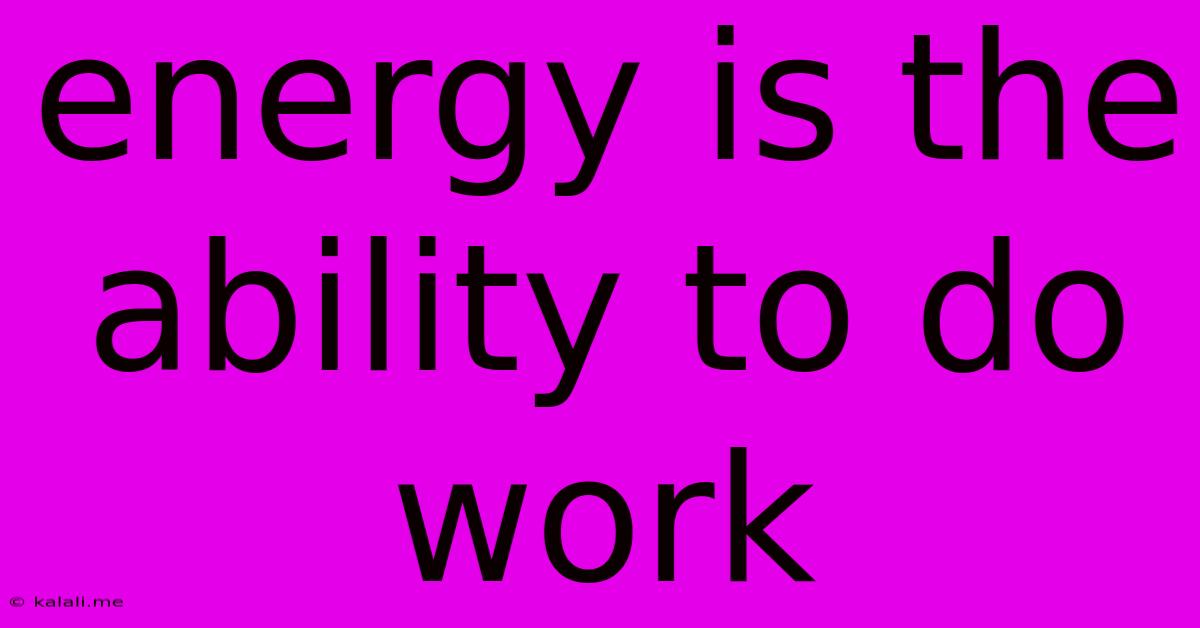Energy Is The Ability To Do Work
Kalali
Jun 05, 2025 · 3 min read

Table of Contents
Energy: The Ability to Do Work
Meta Description: Explore the fundamental concept of energy – its definition, types, transformations, and importance in our daily lives. Learn how energy fuels everything from simple movements to complex technological processes.
Energy, at its most basic, is the ability to do work. This simple definition underpins our understanding of the universe, from the smallest atom to the largest galaxy. Work, in a physics context, refers to any process that involves a force causing an object to move a certain distance. Without energy, no work can be done; no movement, no change, no life. This article delves into the various aspects of energy, exploring its forms, transformations, and crucial role in our world.
What are the different types of energy?
Energy exists in many forms, each capable of performing work in its own way. Here are some key examples:
-
Kinetic Energy: This is the energy of motion. Anything that's moving possesses kinetic energy – a speeding car, a flowing river, even the electrons orbiting an atom. The faster the object moves and the more massive it is, the greater its kinetic energy.
-
Potential Energy: This is stored energy, representing the capacity to do work. A stretched rubber band, a book held above the ground, and water held behind a dam all possess potential energy. This energy is converted to kinetic energy when the object is released. Gravitational potential energy is a common type, related to an object's height above a reference point.
-
Chemical Energy: Stored within the bonds of molecules, chemical energy is released during chemical reactions. Burning wood, digesting food, and the operation of a battery all involve the release of chemical energy. This is a crucial form of energy for life itself.
-
Thermal Energy (Heat): The total kinetic energy of all the particles within a substance. Heat flows from hotter objects to colder ones, driving many processes. This energy is essential for various technologies and is harnessed for power generation.
-
Radiant Energy (Light): Energy transmitted as electromagnetic waves, including visible light, ultraviolet radiation, and infrared radiation. Sunlight, the primary source of energy for Earth, is a prime example. Photosynthesis converts light energy into chemical energy.
-
Nuclear Energy: Stored within the nucleus of atoms, nuclear energy is released during nuclear fission (splitting of atoms) or fusion (combining of atoms). Nuclear power plants harness this energy, while the sun's energy is generated through nuclear fusion.
-
Electrical Energy: The energy of moving electric charges. Electricity powers our homes, industries, and technologies. It's a versatile form of energy easily transformed into other forms.
-
Sound Energy: Energy transmitted through vibrations. While less impactful than other forms on a large scale, sound is crucial for communication and certain technologies.
Energy Transformations and Conservation
Energy is neither created nor destroyed; it simply transforms from one form to another. This principle is known as the law of conservation of energy. For example, a hydroelectric dam converts the potential energy of water held behind the dam into kinetic energy as the water flows, then into mechanical energy to turn turbines, and finally into electrical energy. This continuous transformation is a fundamental aspect of how energy works in the universe. Understanding these transformations is crucial for developing efficient energy technologies.
The Importance of Energy in Our Lives
Energy is fundamental to our existence and modern society. Everything we do, from driving a car to using a computer, relies on the conversion and utilization of energy. Sustainable energy sources are becoming increasingly important as we strive to meet global energy demands while minimizing environmental impact. The efficient use and responsible management of energy are crucial for ensuring a sustainable future. Research into new energy sources and technologies continues to be vital for meeting the challenges of a growing global population.
Conclusion
Understanding energy – its definition, types, transformations, and importance – is essential for comprehending the world around us. From the smallest biological processes to the largest technological advancements, energy is the driving force. By continuing to explore and develop efficient and sustainable energy solutions, we can ensure a brighter and more sustainable future for generations to come.
Latest Posts
Latest Posts
-
When My Fish Is Salty What Do I Do
Jun 07, 2025
-
This What Great Famlies Look Like Logo
Jun 07, 2025
-
Dirty Insults Go Fuck Your Mother
Jun 07, 2025
-
Cannot Update A Component While Rendering A Different Component
Jun 07, 2025
-
How Do You Manually Overwrite The Robots Txt File In Wordpress
Jun 07, 2025
Related Post
Thank you for visiting our website which covers about Energy Is The Ability To Do Work . We hope the information provided has been useful to you. Feel free to contact us if you have any questions or need further assistance. See you next time and don't miss to bookmark.